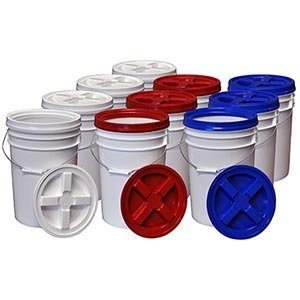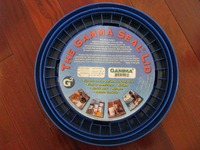30th March 2012
By Gaye Levy
Guest writer for Wake Up World.
Are your ready for our next lesson in long term food storage? The topic today is buckets, lids and gamma seals. Say what says you? Nope, we are not mopping the floors or playing in the sand. Instead, we are going to package up our non-perishable dry foods, add some oxygen absorbers, and seal it all up in a 5 or 6 gallon bucket, which, just so you know, is also referred to as a pail.
Food Grade Plastic Buckets Please
You will hear the term “food grade” mentioned when the subject of long term food storage buckets is discussed. So what do they mean, food grade?
Here is the scoop from the US Food and Drug Administration (FDA):
The FDA requires that plastics used in food packaging be of greater purity than plastics used for non-food packaging. This is commonly referred to as food grade plastic. Food grade plastic does not contain dyes or recycled plastic deemed harmful to humans.
The Society of Plastics Industry has established a seven-point system of categorizing and labeling food-grade plastics. Learning how to tell if a plastic container is food-grade plastic is easy. Look for a triangle-shaped label with rounded corners made of three arrows, then check the number in the center to determine what type of plastic is in the container.
[pro_ad_display_adzone id=”110028″]
The various types are:
1-PET (or PETE): PET or PETE (polyethylene terephthalate) is a clear, tough polymer with exceptional gas and moisture barrier properties. PET’s ability to contain carbon dioxide (carbonation) makes it ideal for use in soft drink bottles. Examples: Soft drink bottles, detergent bottles
2-HDPE: HDPE (high density polyethylene) is used in milk, juice and water containers in order to take advantage of its excellent protective barrier properties. Its chemical resistance properties also make it well suited for items such as containers for household chemicals and detergents. Most five gallon food buckets are made from HDPE. Examples: Milk bottles, shopping bags.
Most but not all food grade buckets are type 2 HDPE. But, and this is a big BUT, unless your #2 bucket is specifically labeled as “food safe”, assume it is not. You can still use it if it is lined with a Mylar bag prior to use.
3-Vinyl (PVC): Vinyl (polyvinyl chloride, or PVC) provides excellent clarity, puncture resistance and cling. As a film, vinyl can breathe just the right amount, making it ideal for packaging fresh meats that require oxygen to ensure a bright red surface while maintaining an acceptable shelf life. Examples: Plastic food wrap, shrink wrap, garden hoses, shoe soles
4-LDPE: LDPE (low density polyethylene) offers clarity and flexibility. It is used to make bottles that require flexibility. To take advantage of its strength and toughness in film form, it is used to produce grocery bags and garbage bags, shrink and stretch film, and coating for milk cartons. Examples: Squeeze bottles, dry cleaning bags
5-PP: PP (polypropylene) has high tensile strength, making it ideal for use in caps and lids that have to hold tightly on to threaded openings. Because of its high melting point, polypropylene can be hot-filled with products designed to cool in bottles, including ketchup and syrup. It is also used for products that need to be incubated, such as yogurt.
6-PS: PS (polystyrene), in its crystalline form, is a colorless plastic that can be clear and hard. It can also be foamed to provide exceptional insulation properties. Foamed or expanded polystyrene (EPS) is used for products such as meat trays, egg cartons and coffee cups. It is also used for packaging and protecting appliances, electronics and other sensitive products.
7-Other: This category basically means “everything else” and is composed of plastics that were invented after 1987 . Plastics labeled as grade 7 should be specifically noted as being “food safe” before they are used to package or handle food.
The definition of the various types of plastics is all fine and dandy but how do you tell – specifically – that a bucket or pail is truly food grade? That is an excellent question especially since there is a lot of misinformation out on the net regarding what constitutes food grade plastic. There are three methods you can use to identify food grade plastics:
1. Purchase new buckets that are marked “food grade” by the manufacturer. In addition to the actual text, you can look for the marks “NSF”, “FDA” or “USDA Approved”.
2. Find free or low cost used buckets that you know have already been used to store food and haven’t been used for anything else. You can find these at bakeries, restaurants, and food processing plants.
3. Call the manufacturer and ask.
Here are some other tips and things to look for when searching for buckets:
- If transportability is important to you, make sure your bucket has a bail or a handle so that it can be easily lifted and carried.
- As long as the bucket is food grade, don’t be afraid to use “free” buckets from the local bakery or fast food joint. Yes, the bucket may smell like pickles but with a good scrubbing with bleach and another day or two airing outside, the smell will be all but gone.
- Still smelly? Put some baking soda or charcoal in the bucket and seal it up for a few days. Take the seal off, rinse the bucket well and it should be sweet smelling once again.
- Important: if a food grade bucket has been used to store non-food items like chemicals, paint, or detergent it is no longer food grade.
Lids and Gamma Seals
Lucky for us, most 5 and 6 gallon buckets utilize a universal, 12” lid. This means that the various lids are interchangeable. What you want to look for is a lid with a rubber gasket fitted in to its inside rim. With the gasket in place, the lid, when securely attached to the bucket, forms a nice seal.
Often times you will find a source for low-cost, used food grade buckets but they come with banged up or damaged lids. Fortunately, it is easy to purchase new lids, independent of the buckets themselves. I recommend that you purchase new lids regardless, since the seal is what is going to prevent moisture and insects from entering your buckets.
Lids come in two basic flavors, the standard lid and gamma seal lid. The standard lid is okay in that it does the job but in my opinion it is difficult to use. To get it on properly, you have to pound it down hard. Needless to say, this is hard on the hands and nails so if you decide to go with the standard lid, I recommend a rubber mallet so that you can tap tap tap around the edges to secure a decent seal.
Getting the standard lid open and back off the pail is also a challenge but luckily, for very little money you can purchase a special tool that will pry the lid open. The tool is called a bucket lid remover and should cost less than $5. Amazon has them as well as your local hardware store – check in the paint department.
The other type of lid uses a Gamma seal arrangement. Think of the Gamma seal as a giant screw top for your bucket. All you need to do is snap the outer adapter ring on to the bucket then screw the inner lid into the outer ring. To make it easy, the gamma lid has a big “X” molded in plastic making it easy to grab on to and spin.
Need to get something out of your gamma sealed bucket? All you need to do is unscrew the inner lid, pull out your product, then screw the lid back down, easy sneezy. Other advantages?
- The Gamma Seal Lid – at least all that I have seen – have a built in stacking channel built in to the outside rim. This means that you can safely stack several sealed buckets on top of each other, saving space.
- They are airtight and leak proof.
- Can be re-sealed over and over again.
- The bugs can not get it (although you product has to be bug and insect free to begin with).
- Easy to use – no special tools required.
- The Gamma Seal Lids can be purchased in various colors if color-coding is your thing (it is not mine).
- An inner bag is recommended but is not mandatory, especially if you are using the bucket for short term storage to keep our moisture and insects. An example would be short term storage of dog food.
The disadvantage? I can only think of one one. The initial investment can be costly. Still, when you consider that they are reusable and are interchangeable with various sized buckets, I think the price is worth it. Plus, if you get the buckets themselves for free, you can dollar cost average and the combination of a bucket and lid will still be a great deal.
In practical use, I prefer a double seal system where I package my goods in 1 gallon Mylar bags with a 300 cc oxygen absorber. I then put the bags in the bucket, seal the bucket with a gamma lid, and I am set. When it comes time to use some of the products, I take off the gamma seal lid, remove a single Mylar bag, screw on the gamma lid and I am good until the next time.
A Final Word on Storing Food in Buckets
The other thing I recommend, for practical purposes – is to mix up the products in each bucket, So, for example, fill a single bucket with a 1 gallon bag each of various beans, another 1 gallon bag with rice, and another with oats. Throw some spices and bouillon in the bucket and you have a grab and go bucket with variety of food stuffs. This is ideal if you need to get out in a hurry or if you want to share some of your product with a loved one.


Also, don’t forget to get out your Sharpie and label the bucket with its contents and the date it was packed. Now that I think about it, a bucket filled in this matter would make a great gift for a non-prepper friend or relative.
So what’s next? Head on out to Walmart, Costco, or your bulk food supplier and start purchasing 25 or 50 pound bags of of dried beans, rice, pasta, oats, sugar, salt, coffee, spices other foods that you know your family will eat. If you buy a little with each paycheck, things will start building up fast. Get your self some Mylar bags and oxygen absorbers, seal them up, and put them in your buckets. Now how easy was that?
Enjoy your next adventure through common sense and thoughtful preparation!
About the Author
Gaye Levy lives and teaches the principles of a sustainable, self-reliant and stylish lifestyle through emergency preparation and disaster planning. She does this through her website at BackdoorSurvival.com, an online preparedness blog that provides lifestyle tools, tips, and thoughts to guide you through the back door of life in the 21st century. With an emphasis on prepping and survival, she writes about and shares practical, thoughtful, and inspirational tools for survival in uncertain times.
Backdoor Survival is currently listed on the Survival Top 50. In addition, Gaye is a frequent guest on the Preparedness Radio Network and the soon to be author of a book on 21st century preparedness. Also known as SuvivalWoman, Gaye speaks her mind and delivers her message with optimism and grace, regardless of mayhem swirling around us.
You can find Gaye through her website at Backdoor Survival, on the Backdoor Survival Page on Facebook, and as Survival Woman on Twitter.
[pro_ad_display_adzone id=”110027″]










